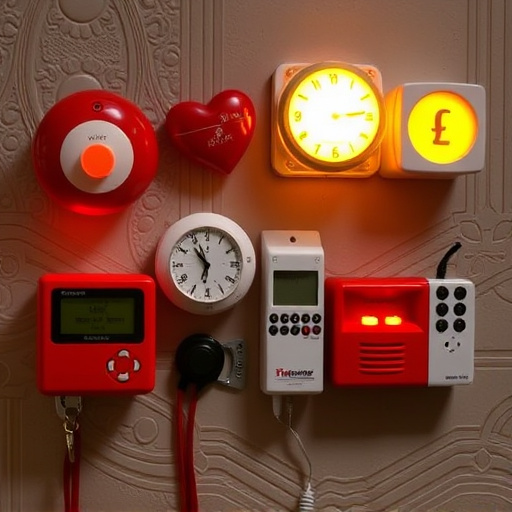Handheld personal protection alarms offer 50-200 meter (Personal Alarm Range in Buildings) safety, effectiveness enhanced by strategic placement and modern features like LED flashlights and GPS tracking. Choose devices matching indoor/outdoor needs, room size, construction, and noise levels for optimal performance. Layered defense combining stationary and handheld units bolsters building security and individual protection.
Handheld personal protection alarm devices have become essential tools for safety, offering a portable solution for individuals seeking peace of mind. These compact yet powerful tools provide a range of benefits, from deterring potential threats to signaling for help during emergencies. Understanding the key features and deployment strategies can empower users to make informed choices, ensuring their safety both indoors and outdoors. This article explores everything from selecting the right personal alarm to effective use in various settings, including buildings, with a focus on maximizing your personal alarm range.
- Understanding Handheld Personal Protection Alarms
- Key Features and Benefits of Personal Alarm Devices
- Choosing the Right Personal Alarm for Your Needs
- Deployment Strategies: Using Personal Alarms in Buildings
Understanding Handheld Personal Protection Alarms
Handheld personal protection alarm devices are compact, portable tools designed to provide immediate safety and security for individuals in various situations. These alarms offer a simple yet effective way to deter potential threats and attract attention when needed. Understanding their functionality is crucial, especially in enclosed spaces like buildings, where the personal alarm range can significantly impact their effectiveness.
The range at which these devices can emit sounds and signals varies among models, typically ranging from 50 to 200 meters (164-656 feet). In buildings, factors such as construction materials, layout design, and ambient noise levels can affect this range. For optimal performance, it’s essential to choose a device with a suitable range for the specific environment. Proper placement during use also ensures that the alarm’s sound travels effectively throughout the space, increasing the chances of attracting help or scaring off intruders.
Key Features and Benefits of Personal Alarm Devices
Personal alarm devices are designed to offer individuals a sense of security and protection, especially in situations where one might feel vulnerable or at risk. These compact yet powerful tools have become increasingly popular for self-defence, both outdoors and indoors. One of the key features is the ability to emit an ear-drowning loud sound that can startle potential attackers and alert nearby people, which is particularly useful in enclosed spaces like buildings. The Personal Alarm Range in Buildings varies, but advanced models can project sounds up to 120 decibels or more, ensuring maximum impact within a radius of several hundred metres.
Beyond the loud siren, many modern personal alarms incorporate additional features such as LED flashlights, GPS tracking, and panic buttons that allow users to quickly call for help. These devices are often water-resistant or waterproof, making them suitable for outdoor adventures or emergency situations in wet environments. Their small size makes them easy to carry, whether clipped onto a belt loop, backpack, or key fob, ensuring individuals can access their personal alarm when needed, enhancing safety and peace of mind both at home and away.
Choosing the Right Personal Alarm for Your Needs
When selecting a handheld personal protection alarm, considering your specific needs is paramount. Different scenarios require distinct features and capabilities. For instance, if you’re choosing an alarm for indoor use within buildings, focus on devices with powerful sounds that can penetrate through walls and ceilings to alert others in nearby spaces. The Personal Alarm Range in Buildings varies based on factors like room size, construction materials, and environmental noise levels.
Conversely, outdoor personal alarms should withstand harsh weather conditions and offer longer battery life given the potential for extended use. Look for water-resistant designs and alarm devices with multiple settings to adapt to various environments. The ideal choice will seamlessly integrate into your daily routine, ensuring you feel secure without compromising portability or convenience.
Deployment Strategies: Using Personal Alarms in Buildings
When it comes to deploying personal alarm devices in buildings, strategy is key to maximizing their effectiveness. One common approach involves situating alarms at strategic points within each room—doorways, windows, and corners being ideal locations due to their range capabilities. These handheld devices often boast a personal alarm range of up to 50 meters (164 feet), ensuring users can activate the alarm from a safe distance if needed.
In larger buildings or areas with complex layouts, implementing a layered defense is recommended. This might include both stationary alarms and portable units. Stationary alarms can be installed at key entrances and exits while personal alarms remain in users’ possession for immediate use. Such a dual-approach strategy not only enhances overall security but also provides individuals with a powerful tool to protect themselves should the unthinkable occur.
Handheld personal protection alarm devices are versatile tools that offer peace of mind and enhanced safety. By understanding their key features, choosing the right model for your specific needs, and employing effective deployment strategies within buildings, you can maximize their benefits. Whether as a personal safety measure or for professional use in diverse settings, these alarms provide an extra layer of protection, giving users confidence and the freedom to go about their daily lives with added security.
